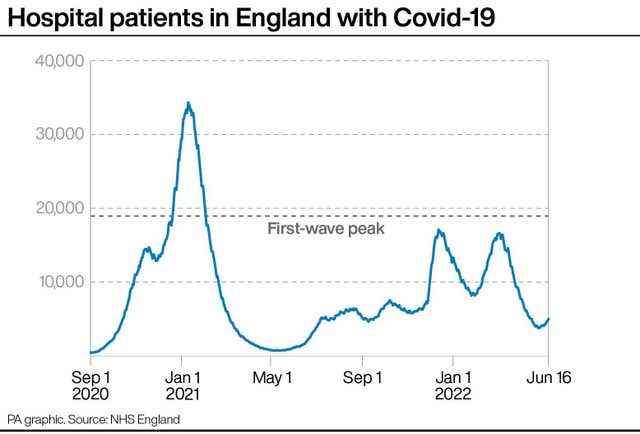Covid-19 infection levels rising in all four UK nations
Prevalence of the virus remains well below the record high reached in the spring.

Covid-19 infections have risen in all four nations of the UK, with the increase likely to be driven by the Omicron variants BA.4 and BA.5, figures show.
The number of people in hospital with Covid is also showing signs of an upwards trend, suggesting the virus is once again becoming more prevalent across the country.
A total of 1.4 million people in private households are estimated to have had the virus last week, up 43% from 989,800 the previous week, according to the Office for National Statistics (ONS).

Total infections are now back at levels last seen at the start of May, but remain well below the record 4.9 million at the peak of the Omicron BA.2 wave at the end of March.
The ONS said the latest increase was “likely caused by infections compatible with Omicron variants BA.4 and BA.5”, which are now thought to be the most dominant variants in much of the UK.
BA.4 and BA.5 are newer strains of coronavirus that were recently classified as “variants of concern”, after analysis found both were likely to have a “growth advantage” over BA.2.
In England, 1.1 million people were likely to test positive for Covid-19 last week – the equivalent of around one in 50.
This is up week-on-week from 797,500, or one in 70.
Wales has seen infections rise to 64,800 people, or one in 45, up from 40,500, or one in 75.

The virus is estimated to be most prevalent in Scotland, where 176,900 people were likely to have tested positive last week, or one in 30, up from 124,100, or one in 40.
Northern Ireland has seen Covid-19 infections jump to an estimated 42,900 people, or one in 45, up from 27,700, or one in 65.
The percentage of people testing positive is thought to have increased among all age groups in England and all regions except the North East, where the trend is described as “uncertain”.
Infection levels are highest among 50 to 69-year-olds, where 2.7% – one in 35 – were likely to have had the virus last week.
The estimates are the latest in a series of figures in recent days to suggest a rise in prevalence of the virus is under way.
The number of people in hospital in the UK with Covid-19 has started to increase, though the trend is not identical across the country.
Some 5,008 patients in England had Covid-19 on June 16, up 23% on the previous week, while in Scotland 748 patients were recorded on June 12, the latest date available, up 17%.
Wales and Northern Ireland have recorded smaller week-on-week increases but have yet to show a steady rise, Government figures show.
Patient numbers across the UK remain well below the peaks reached during previous waves of the virus.
There were 221 suspected outbreaks of Covid-19 in the UK last week, up from 96 the previous week and the highest since the start of May.
Some 153 outbreaks were detected in care homes, up week-on-week from 67, with 102 outbreaks having at least one linked case that tested positive for Covid-19, according to the UK Health Security Agency.
There is no evidence of an increase in intensive care unit admissions, however.
The number of registered deaths involving coronavirus also remains low.





